
Earlier in the month, we reported on James Pearson making the first repeat of Dave MacLeod's mysterious Ben Nevis route Echo Wall (E11 7a), a route that, until Pearson's ascent, had been left unrepeated - and rarely attempted - for more than sixteen years.
The route, which MacLeod left ungraded between the years of 2008 and 2023, lies high on the east face of Tower Ridge, and holds a number of difficulties for any climber wishing to climb it, including being difficult to access, being situated in an area known for terrible weather, and offering very little in the way of sturdy gear, all whilst demanding highly technical climbing above a potential death fall.
We got in touch with James shortly after he climbed the route to find out more about the ascent, how he prepared for it, how the climbing broke down, and how it compared to some of the other tough repeats he's made:
James, congratulations on climbing Echo Wall! I imagine it's a route that's been on your radar for some time, but it must have been a tough one to decide to go after. When did you first commit to dedicating some time into it?
Thanks Xa, to be honest it still hasn't quite sunk in yet. We've been pretty busy over the last week working around the Olympics in Paris for La Sportiva, and since I topped out on the route it feels like it's just been one long hectic hike/drive/coaching session/presentation. We just finished today and are making our way back home, so I guess it's all going to settle in over the next few days.
Echo Wall has definitely been on my mind for quite awhile, and it somehow felt like the next logical challenge after Bon Voyage. We spent a month during the summer of 2023 in North Wales on a family holiday, and my plan was to keep an eye on the weather forecast up in Scotland, and to nip up for a few days with Caroline if we noticed a decent window. That trip came to an end and I'd never seen more than a day and a half of sun forecast! I realised that if I was serious about checking out Echo wall, I'd realistically have to come over specifically and spend some time in Scotland, to be ready whenever the weather gods gave the green light.
We'd originally planned to spend most of the summer in Scotland as a family, renting a big enough place to invite my parents for a few weeks to help look after the kids and free up Caro to belay me on the route if I ever felt close. Unfortunately, earlier this year my sponsorship situation changed a bit out of the blue, which in short meant money suddenly became pretty tight, and we just couldn't afford to do this anymore.
At first I thought about cancelling all together, but in the end Caro convinced me to go on my own in our van whilst she stayed with the kids at my parents in the Peak. If by some miracle I got enough dry days in the two weeks we could spare, she would come up to join me for the last few days to belay. It seemed really far fetched to imagine all those stars aligning, but in the end that's exactly what happened!
I didn't know much about the route before hand, only what you can gather from reading Dave's initial blog posts on it and watching his film. I also knew that Steve (McClure) had been up there a few times to try and get on it and had either failed to find it whilst lost in the mist, or been so badly rained on and he hadn't even left the car. In short I was expecting it to be a bit of an epic, but I was hopeful that even if the weather was truly terrible, I might at least be able to drop a rope down the line and see what the holds and gear look like, even if I couldn't really climb on it.
There was such a mystery surrounding the route that I felt like even this small achievement would've made the trip worth it, and it would've been enough to decide if I wanted to invest even more time into it over the following years.
In an interview last year, I asked you what gave you the most joy in climbing at the moment, you response was:
'New places, hidden gems, big run-outs, and short walk-ins'.
How does Echo Wall fit into these categories?
New places, hidden gems, and big run-outs are things that I've always appreciated. Short walk-ins became a lot more important when we had kids, as most of the time we try to go climbing with them around. You really can do a lot with children, but it's also smart to choose your battles, and I never once kidded myself that I'd be able to bring them up there.
Since I knew I would be alone for the majority of this trip, the walk-in didn't put me off too much, at least in terms of the distance and time of actually doing it. However, I also knew that after five years of generally really short roadside sessions, my legs and long day endurance capacity in the mountains was probably going to be pretty bad, and this might make climbing at my limit pretty complicated, especially for more than one day in a row.
I remembered Dave saying that one of the keys to him climbing Echo Wall was developing a lot of mountain fitness, and considering he's been climbing in those hills since he was a teenager, I imagine he was pretty fit back in 2008.
Can you talk us through your physical preparation for Echo Wall? Did you do any specific training for it, and, if so, what did that training entail?
I'd had a conversation with Dave shortly after he did the route back in 2008 and he'd given me a quick breakdown of the sections, which confirmed what you can see in the video, that it's going to be a fairly pumpy affair, with a really hard boulder in the middle, and a tricky (and very scary) sequence up at the top. Since bouldering has always been one of my strong points, and I'd been bouldering at my very best level for most of 2024, I knew that to have the best chance on Echo Wall, I needed to blast out a few months of endurance and convert some of that power over into fitness.
Trad endurance is a funny thing because even if the climbing style looks like power endurance or boulder endurance, you often spend so much time fiddling in small gear that you end up with a really deep long endurance style pump. With that kind of pump it's really hard to execute hard moves, so I also didn't want to lose too much of my top end power as I wanted the boulders to feel really easy.
Ideally I would've liked to match my fitness to the style of the route, or more precisely the challenge of climbing something pretty hard after a very long and physical approach, in less than ideal conditions, and after potentially several climbing days in a row. There are loads of places with similar styled routes in the Alps (bolted, not trad). But with kids and other work commitments this type of training wasn't possible, it would have just taken way too long. I settled on the next best thing that I could do, which was short (duration) really intense boulder endurance circuits on my small home board twice a week, and another short session or two outside, to keep me comfortable moving on rock.
I've been working with Ollie Torr from Lattice Training for the last three years, and I've been constantly amazed at how he is able to get me in exactly the sort of shape I need for the very varied projects I've wanted to try, usually with limited access to specific training facilities. I think a real key in any athlete trainer relationship is an almost blind faith that your trainer knows exactly what you need to do, and even though I'd thrown another spanner into the works by asking Ollie to extend my boulder season so I could finish off a few of my local projects, as the trip to Echo Wall drew nearer I could feel things clicking into place. By the time we left for the UK, I had never been fitter on my home wall circuits (though I had barely put a harness on in almost six months!), which is always a great way to start a trip.
Now - and perhaps more importantly - can you tell us about your mental preparation for the route? How did you go about working towards putting in a lead attempt on a route with such a dangerous reputation? Was soloing 29 dots part of that strategy?
Believe it or not, I didn't do any specific mental training for Echo Wall, at least not to prepare for the fear of climbing a dangerous route. I know this was quite important for Dave, and as part of his preparation he specifically soloed a hard sport in Margalef to show himself that he had what it took to climb that sort of level in a really dangerous situation. I've always been quite lucky that the pressure of climbing dangerous routes tends to bring out the best in me, and I'm often at my calmest when the consequences of failure are severe.
29 Dots was never meant to be anything other than a fun experience on a really beautiful line, but ironically, the fact that I actually had an epic on that route probably helped me to look at Echo Wall with a more realistic and cautious approach.
Deciding when you are actually ready to take such a risk is never black-and-white, and the fact that Echo Wall is a hard route to get in good conditions, I can imagine how you could feel prematurely forced into getting on the lead for fear of missing out. Since getting it so wrong on 29 Dots, I've stepped back from a few other sketchy highballs that I would have probably just gone for before, and returned to climb them better prepared on another day, and had a really great experience. If in doubt, there will always be another time.
However, like I said earlier in the article, I had some issues with one of my partners earlier this year, and it's been complicated separating my own authentic motivation from, in short, trying to prove to them that I'm not past it! I didn't want my decision to try Echo Wall to be at all influenced by this, so I started therapy to help me come to terms with the change, and disconnect my self worth from decisions out of my control.
Can you talk us through the complications associated with trying Echo Wall - namely the remoteness, the difficulty of getting the gear there, and the difficulty of finding a weather window long enough to try it!
For anybody that has ever climbed on Ben Nevis, that fact alone is probably enough to have a good idea of how complicated trying Echo Wall might be. For the rest of the climbers out there (like me) who have never set foot on that mountain before, you have to combine a very long hike (two to three hours in total depending on how fast you walk) where the last thirty minutes is especially steep and uncomfortable (a miserable scree slope), with some of the worst weather in the UK.
Saying that the weather up there can be bad doesn't really do it justice. Everyone knows that the forecast in the UK is pretty unreliable, and that a considerable amount of the rain that falls on our fair island does so on the West Coast of Scotland. The weather on Ben Nevis, however, makes Fort William feel like the Caribbean. It can be blue skies and sunshine down in the Glen and the Fort, but at the summit of the Ben it is peeing it down and shrouded in mist.
Even when it's not raining, Observatory gully seems to be almost always misty, and in the two weeks I spent up there, I only had two days on Echo Wall where I could see the sky. To make matters worse, Echo Wall faces almost perfectly North and never sees the Sun, so it takes ages for any seepage to dry. Trying the route with either the bad weather, or the really long approach, would still be really tough, but trying it with both of them together was definitely a logistical complication above anything I've ever had to deal with before.
What does it feel like to climb in such a remote location?
A big part of the difficulty of the route came from just being a bit freaked out by being up there, meaning I really struggled to relax and get into a flow with my climbing.
It's quite hard to explain… it wasn't that I felt scared at every moment while swinging around on my rope, but linking the sections of the route seemed to be a lot harder than I felt it should be based on how hard the individual moves felt, and the only explanation I have is that I must have been constantly over gripping. The mist, the rain, the ravens, and the echoes all give the place a spooky vibe.
What was the hardest bit of the route in your opinion?
The hardest physical section is just after the roof, where luckily you feel quite fresh as you've just come out of a good knee-bar rest. This section is reasonably safe, and although the gear below the roof is a little odd, and you've extended it quite far to avoid a rope-drag, I'm pretty sure that a fall here would be fine.
This was the section of the route I was most unsure about on any attempt. I knew I could quite easily fall here from being too pumped after placing the gear in the roof and not being able to recover well enough in the knee-bars, or simply from making a mistake on what are even in isolation pretty hard and complex moves.
The overall crux, however, is definitely the final boulder problem after the upper rest. If Echo Wall was bolted, I don't think this would necessarily feel like the redpoint crux of the route, because in the grand scheme of things, the moves are not that hard and the rest is reasonably good, but I'm also certain that plenty of people would fall here because it's still a really tricky bit of climbing, and you never recover as well as you would like.
The fact that Echo Wall is not a sport route, and that the protection for this crucial section is far from reassuring, turns it into another thing entirely. The traverse to the arete is on small, difficult to hold crimps, and there is one crucial foot hold that is much worse than you would like it to be. I probably practised this boulder problem thirty or forty times, once climbing it back-to-back more than ten times in a row to prove to myself I could climb it when really tired. Never did it feel completely solid, even when 100% fresh.
Any trad climber knows how heavy the prospect of a serious fall can be to carry, and on Echo Wall, the poor protection in this final section makes the rest of the route feel like a preface. The choice you make in that final rest is everything.
How does Echo Wall compare to some of your other hard repeats such as Lexicon, Tribe, and Rhapsody?
It's never easy to compare routes with very different characteristics, but if I start by focusing on physical difficulty alone, I'd say that Echo Wall is probably harder than Lexicon, but easier than Rhapsody which is, in turn, easier than Tribe. Obviously, some of those routes suit me more than others, and I also climbed Rhapsody over ten years ago, so it's tough to know how it would feel today.
However, if we bring danger and other logistical issues into the mix, then Echo Wall takes on another role altogether, and now having climbed it, I think I finally understand what Dave was saying all those years ago. Whilst the physical difficulty of Echo Wall is definitely far from the 8c+/9a a lot of people believed it might be, I think you have to be operating at that level to really stand a chance of climbing it. The physical difficulty of the route has to be at least a few French grades lower than your max level to allow yourself the possibility to climb it in unfavourable conditions.
Talk us through the gear - what was your assessment of the gear you already knew about, and did you find any new placements?
I watched the video of Dave climbing Echo Wall many times, and even took notes on the gear he used and his ropework tactics.
Most of the gear I placed on the route was identical to Dave's, give or take maybe using a different brand of friends. I did, however, change a couple of pieces to other things that I felt were more reliable, and doubled or tripled up some of the placements where Dave only placed one. Instead of the friend 6 that Dave used to protect the roof, I placed a number one ball-nut in a tiny slot just behind it.
I found it quite funny to switch out one of the world's largest pieces of active protection with the world's smallest, and although a number one ball-nut won't inspire confidence in most people, they are actually extremely strong for their size and, if placed well, can feel very solid. One advantage of this change was simply avoiding carrying the massive friend up the steep lower wall, but mainly it allowed me to better use the hold where the cam was placed, which made using my left knee-bar quite a bit more comfortable than it would be without.
I think the biggest change between Dave's gear and my own was that I chose to place a lot more pieces in the top wall and the final rest. Whilst Dave had definitely already found the best pieces here, I felt by adding few more and equalising and tensioning everything down with a separate tag line, I was only increasing my chances of it holding a fall.
Skyhooks and micro wires are always hard to assess, especially when the rock itself may be a little suspect. By no means did I think this nest of protection was bomber, but I also didn't feel like I was soloing. Setting off on the route I still planned to assess how tired I felt in the last rest, and would have lowered off from here if I hadn't been able to recover, but it definitely gave me peace of mind to know that if I did make a bad decision and end up falling onto this gear, it wasn't absolutely guaranteed certain death. Ironically, this probably helped me to stay a lot calmer in the final boulder and avoid over gripping in this section, which could well be the difference between doing it and falling.
The downside of placing all this extra gear was the amount of time it took me to get it set up properly.. Any time you are placing gear you are not resting, and from the video we took of the route I can see that I spent about ten minutes fiddling in and equalising all the wires and sky-hooks. It then took me about another five minutes to feel recovered enough to set off on the last section. In a perfect world I would've rested there even longer, but I noticed that my legs had started to shake from being stuck in the same position for too long, and shaking legs is the last thing you want for standing on that crucial foothold!
Placing only two pieces in this rest would definitely be physically a lot easier, but you'd have to climb the final section knowing there is no turning back, no escape. It's all about understanding your own strengths and weaknesses and deciding what will be best for you, and it will be interesting to see what other people do here in the future.
Have the advancements in gear and climbing equipment over the past sixteen years made any difference to the route?
The first thing that comes to mind is kneepads. As you can see Dave making one specifically for the knee-bar rest in his film about the route, we can tell he felt they were very important. I tried the knee-bars without pads, and they feel much, much worse, so pads clearly make a difference, but what's a lot harder to know is how much better today's pads are than the pad Dave made back in 2008.
I also used two knee-pads to allow me to rest using both knees as opposed to just one as Dave did. Whether Dave didn't think to try it, didn't like it, or did not have the material to make another pad I don't know, but I personally feel that being able to use both knees for the rest was pretty helpful… not game changing, but better than resting with only one.
At the end of the day, the main thing is how much time you can spend in a relaxed state in the knee-bars. I knew they would be important, so I created a replica at home and have been training my knees for the last two months, two or three times a week. You get to see really good progress training muscles you don't often use, and I was quickly able to double, and then triple the time I could spend in my rest. Whether it's the specific training, or the modern pads, in the actual route I think I was able to stay a little longer than Dave in this rest (probably around one minute as opposed to the forty seconds that Dave did) which definitely helped me feel fresh for the physical crux of the route.
After this, the next biggest change might be my sky-hooks, which are made in Patagonia by a company called Fierro Equip, and - as far as I know - are the only sky-hooks rated to take a lead fall. Regular skyhooks can fail as low as 2kn, which is plenty for aid climbing, but really not much for a fall (it's like a ¼ micro nut), so having super strong hooks removes one of the main problems of falling onto hooks (that the hook bends and deforms and "slides" off the hold).
Obviously the hook placement is only as strong as the rock, and having hooks that don't flex may even be more likely to break the rock, but as long as the rock seems solid and you can find a way to stop them moving on the hold, I think they are a very useful piece of protection unlike the last resort that they used to be!
Can you talk us through the climbing on the route? How did you break it down in your head?
Dave originally told me that he thought the breakdown of Echo wall was something like 8a+ up to the roof and the knee-bar, and then 8b to the top. He thought the 8b could also be broken down into a 7C+ boulder problem followed by some easy moves, the final rest, and then another boulder, though he never gave me a grade for this one. I think his assessment is pretty on point.
At first, I felt like the bottom wall was quite hard for 8a+, as I've never spent multiple days working out the moves on an 8a+, but then again, working really steep trad routes like that is always so much harder than sport climbing at the same grade level, because you just simply can't easily get into the rock, and you waste so much energy just moving around on the ropes.
Once I had finally figured out a good method, I linked it on my first go, so it can't be too hard, however, there is a very small crimp on it that you have to pull really hard on, and I don't think I've ever done a move that hard on an 8a+!
I think I found the boulder problem just after the rest a little easier than Dave did, but I am quite a bit taller than him and this could make a difference on the first couple of moves. Inversely, a couple of moves just after that I found it quite hard due to my height, but also my really inflexible hips, and struggled with a drop-knee and a cross over that Dave seems pretty comfortable with in the video.
Whilst the top rest was slightly better than I had expected, it's still not a great rest and your recovery depends significantly on how pumped you are when you arrive. My main problem was with my feet as after a certain amount of time trying to recover my forearms, my legs and toes started to get tired, meaning if I continued resting I'd be a lot more likely to make mistakes with my footwork in the next section, something you really don't want to do.
The final boulder of the route is probably around 7A. It's not particularly hard, and once I had my sequence I almost never fell off, but at the same time I also never felt totally comfortable on the moves. The holds themselves are very small and awkward, meaning you really have to force yourself to take them well and control your body movement around them. You can't relax into any of the holds and use friction to help the job, instead it's a series of really strenuous active positions which, when tired and scared, can feel really hard indeed!
At the end of this section there is a really good jug, and some reasonable gear form of a sling and a small friend. From here to the top the route is probably around 6c, but the gear is poor and I was definitely squeezing the life out of every hold just to make sure I didn't mess up!
Let's talk about the ascent itself, was everything as you expected, or were there any surprises?
In general the lead went really well, and despite a few wet holds in the bottom wall that forced me to change my sequence a bit on the fly, most things went as planned. The biggest difference between my previous try on preplaced gear and my real lead was how long it took me to place the nest of protection in the final rest.
I'd always do my best to simulate placing the gear whilst I was top roping, but I'd totally underestimated how long it would actually take as the protection is so fiddly that you really can't place it quickly. As I said before, it took me about ten minutes to get everything in just as I wanted them, which meant I was considerably more pumped than I'd expected to be at that rest.
Though I managed to get a lot of it back, I was definitely more pumped than I would have liked to have been when starting the top boulder problem, but knowing I had previously climbed these moves far more tired than this told me as long as I stayed calm and climbed well everything would be fine. I definitely over gripped to make sure that my hands wouldn't slip and, in an ideal world, I would've liked to feel more relaxed in this section, but even though the final long lock-off felt tough, I knew I had more to give if need be.
Have you ever spoken to Dave about the route?
I chatted briefly with Dave about the route shortly after he made the first ascent, and got in contact with him again more recently to ask his advice on the route, including the best period to come over to try it. He also gave me some beta on climbing and training spots for the rainy days, and told me there were some boards at the climbing wall in Fort William, and a perma-dry Cave on the West coast.
You mentioned that Echo Wall had been priority no.1 for you since you climbed Bon Voyage, do you already have your sights set on your next hard project?
It's actually the first time in quite a few years that I don't have a definite project in mind. To be honest, I never expected to climb Echo Wall so fast, and assumed I'd be going back to Scotland for at least the next year or two.
In the short term that's not going to be a problem because it's definitely Caro's turn to focus on something for a while whilst I spend a little more time with the kids. After that, let's see.
There are still a few things at Annot that I would like to look at, and one day in the future, I'd love to take the trans-Siberian express and then a ferry to Japan to look at Keita's multi-pitch trad masterpiece at Mizugaki.
James told us that he's still gathering his thoughts about the grade of the route, and that he aims to share these thoughts in the next couple of weeks.

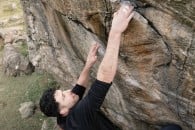































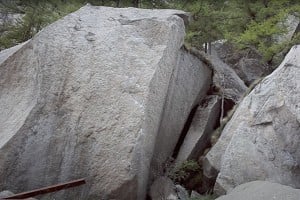
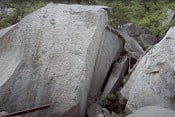
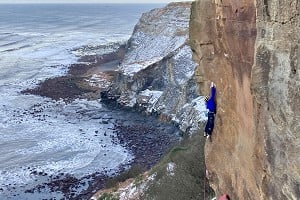
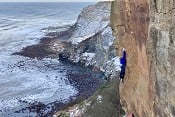
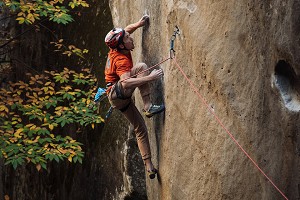

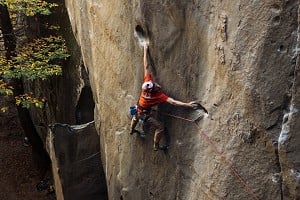
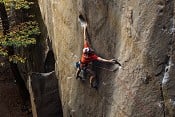
Comments
Looking at the gear is the blue cam with green sling a new not yet released Wildcountry 0.3 cam?
Good article, nice to have a lengthy one for such a mythical route.
I notice although sport grades are mentioned, as are similar difficulty trad route, perhaps unsurprisingly a trad grade isn't specifically mentioned.
I happened to put 8b+ and Dangerous (not very or extremely dangerous) into the eGrader, which spits out Hard E11...
That's partly my mistake, James did actually mention that he's still gathering his thoughts about the grade of the route, and that he aims to share his thoughts on this in the next couple of weeks. I meant to add this at the bottom of the interview but it obviously slipped my mind - I'll add it now!
Really great interview thanks.
Also, I want one of those rated skyhooks ;-)
Yes, no, maybe.